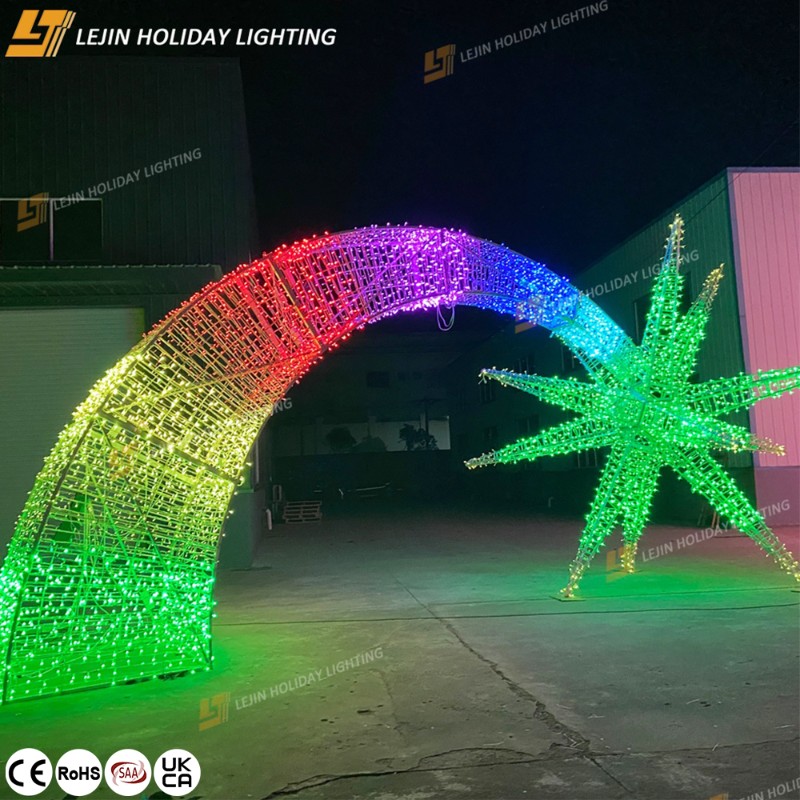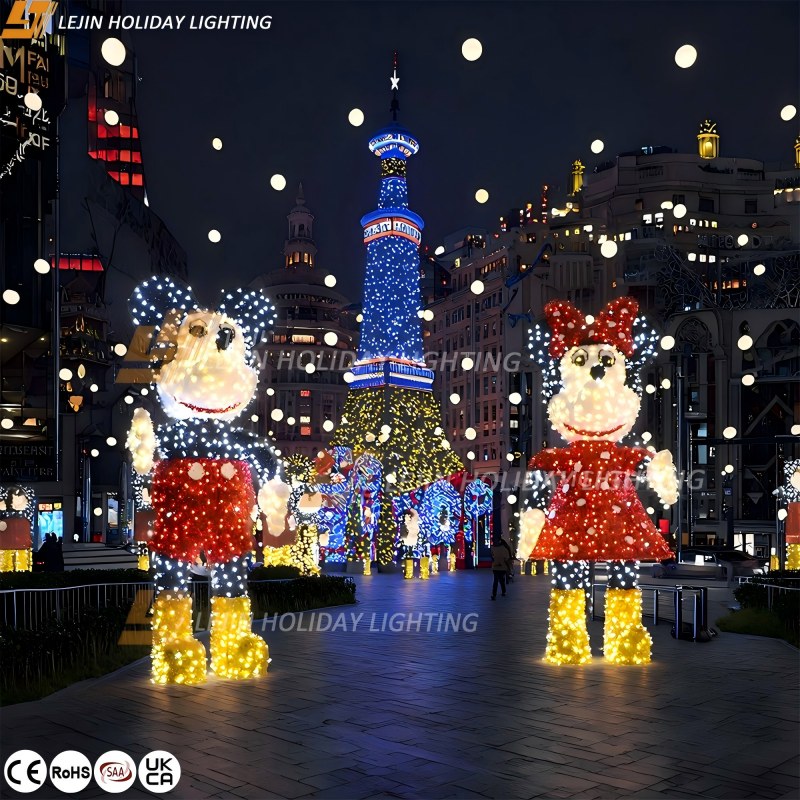Outdoor 3D Christmas Motif Lights: Durability & Selection Guide
Sep 10, 2025
Core Challenge of Outdoor 3D Christmas Motif Lights: Why is Durability the First Hurdle in Selection?
In Christmas outdoor decorations, 3D motif lights have become the highlight of municipal landmarks, commercial plazas, and park landscapes due to their three-dimensional and full visual effects. However, the complex and changeable outdoor environment makes "durability" the primary consideration for project implementation. In winter in Europe and America, temperatures often drop to minus ten or even twenty degrees Celsius. Traditional motif lights are prone to issues like lamp bead detachment and frame deformation due to insufficient low-temperature resistance of materials. If sealing is not in place during rainy or snowy weather, water vapor seeping into the lamp body will cause frequent malfunctions. Long-term exposure to strong winds and ultraviolet rays will also accelerate the aging and fading of the lamp body, which not only affects the decorative texture but also increases the cost of repeated purchases. For customers undertaking large-scale outdoor projects, rework caused by lamp damage will not only delay the construction period but also incur additional labor and material expenses. Therefore, durability must be prioritized during the selection phase, and suitable products should be matched according to specific scene needs to avoid potential risks from the source.
Three Core Indicators of Durability: Comprehensive Analysis from Material to Craftsmanship
The durability of outdoor 3D Christmas motif lights is not determined by a single factor but by the combined effect of three dimensions: "structural framework, lamp bead & circuit, and protective craftsmanship," which need to be evaluated in detail one by one. As the "skeleton" of motif lights, the mainstream materials for structural frameworks are aluminum frames and iron frames. Aluminum frames have excellent rust resistance and load-bearing capacity, making them suitable for large-size shapes such as Santa Claus and Christmas trees, and can withstand moderate to high-intensity winds. Iron frames are lightweight, suitable for small and medium-sized shapes and scenarios with limited installation space such as building facades. During selection, the corresponding material should be chosen based on the wind conditions and shape size of the installation location. For example, large shapes in open squares should prioritize aluminum frames, while small shapes in commercial street windows are more suitable for iron frames. Lamp beads and circuits are the core of lighting, directly affecting service life and safety. Lamp beads should prioritize low-temperature startup LEDs to ensure normal lighting and slow brightness attenuation in extremely cold environments. Circuits need to use cold-resistant and flame-retardant wires that can adapt to temperature changes from extreme cold to high temperature, avoiding low-temperature brittleness or high-temperature aging. In addition, the connection points between lamp beads and circuits must be properly sealed to prevent short circuits caused by water vapor infiltration. The sealing rating of connection points for high-quality products should meet the industry's general IP65 standard. Protective craftsmanship is the last barrier against outdoor erosion. The lamp body housing is recommended to be made of high-quality materials to reduce the risk of water ingress through gaps. The surface coating should contain anti-ultraviolet ingredients to delay fading caused by sunlight exposure, ensuring that the color remains bright after years of use. Some high-end products also add rubber sealing rings at the connection between the frame and the lamp body to further improve waterproof performance, making them more suitable for rainy and snowy areas.
Four Core Dimensions of Selection: Beyond Durability, More Adaptation to Needs
Durability is the foundation, but selection also needs to be comprehensively judged based on "scene requirements, budget planning, effect presentation, and installation conditions" to avoid the misunderstanding of "only focusing on durability while ignoring practicality." In terms of scene requirements, municipal landmarks need to balance durability and iconicity, prioritizing extra-large frames with high-brightness LED motif lights to ensure clear visibility from a distance. Commercial plazas focus on attractiveness and interactivity, and smart models with dynamic effects that support remote adjustment of light changes can be selected. Park landscapes need to be close to natural styles, and small and medium-sized motif lights with warm light beads can better create a cozy atmosphere.
For budget planning, ordinary models are affordable, suitable for projects with limited budgets and basic decorative needs such as community parks. Although smart models have slightly higher procurement costs, they have functions such as remote control, fault warning, and energy consumption adjustment, which can reduce long-term operation and maintenance costs. For medium and large-scale projects, the labor and energy costs saved by smart models can offset the initial price difference in a short period. In terms of effect presentation, brightness needs to be adjusted according to the lighting conditions of the installation environment: high-brightness lamp beads are suitable for strong light environments such as commercial streets, while medium-brightness warm light beads are used for low-light environments such as park paths. In terms of color, municipal projects mainly use classic red, green, and white, while commercial projects can try gradient colors or custom colors. Dynamic effects need to fit the scene's tone: municipal scenes should be simple and soothing, while commercial scenes can be more lively and rich. Installation conditions also need to be considered in advance: shapes installed on walls need to choose lightweight materials to avoid insufficient load-bearing; large shapes placed on the ground need to be equipped with stable bases to prevent tipping; when the power supply is far away, low-voltage power supply products should be prioritized to avoid performance loss caused by excessively long circuits.
Scene-Specific Selection Solutions: Accurate Adaptation from Municipal to Commercial
Different scenes have distinct needs, and selection suggestions combined with actual cases are more practical. For the municipal landmark scene, take the 3D Christmas tree project in a European city square as an example: an industrial aluminum frame is used to resist winter low temperatures and strong winds, matched with high-brightness LEDs to create dynamic effects. The protective craftsmanship adopts a one-piece injection-molded housing and rubber sealing rings, which have been used without failure for multiple Christmas seasons, and the operation and maintenance cost is much lower than traditional products. For the commercial plaza scene, such as the 3D reindeer shape project in a North American shopping mall: an aluminum alloy frame is used to reduce installation load-bearing, matched with an intelligent control system to remotely adjust dynamic effects. The lamp body surface is coated with an anti-ultraviolet coating, and the timing switch function reduces energy consumption, which not only improves interactivity but also controls usage costs. For the park landscape scene, such as the 3D snowflake group project in an Asian city park: lightweight aluminum alloy is used to make multiple sets of small and medium-sized shapes, matched with warm white LEDs to create a soft atmosphere. Cold-resistant wires are suitable for the cold winter environment, requiring no frequent maintenance after installation and having a long service life.
Practical Points for Installation and Maintenance: Key to Extending Service Life
After selecting the right product, scientific installation and maintenance can further improve durability and reduce the full-cycle cost. During installation, it is necessary to first clean up on-site debris to ensure that the installation foundation is flat and firm; the frame should be fixed with appropriate fastening accessories and arranged at a reasonable spacing to prevent deformation due to uneven force; the circuit layout should avoid entanglement, the exposed outdoor parts should be protected with sleeves, and the joints should be waterproof and sealed; for smart models, the control system should be debugged in advance to ensure stable signals. Daily maintenance requires regular inspections, focusing on checking whether lamp beads are damaged, circuits are aging, and frames are loose; timely clean snow and water on the lamp body surface after rainy and snowy weather to avoid overload or water vapor infiltration; before winter, rust-proof treatment can be done on the frame connection points to prevent freezing and cracking; smart models can monitor the operating status in real-time through the backend, and issue warnings immediately when abnormalities are found to avoid expanding faults. After the Christmas season, clean the stains on the lamp body surface, handle it gently during disassembly to prevent deformation; sort and organize the lamps and accessories, and store them in a dry and ventilated warehouse to avoid rust caused by a humid environment; ordinary models need to be individually packaged to protect the lamp beads, while smart models need to be disconnected from the power supply before storage, and powered on for testing in advance before next use.
Case Evidence: Practical Value of Durability and Reasonable Selection
An international decoration company once used ordinary 3D motif lights when undertaking municipal Christmas projects in multiple European countries. However, low winter temperatures caused a large number of lamp failures, resulting in high rework costs. Later, it adjusted its selection strategy: using high-protection smart models in core municipal areas, and ordinary models with qualified durability and high cost performance in auxiliary areas such as communities. As a result, the failure rate dropped significantly, operation and maintenance manpower was obviously reduced, and the comprehensive cost decreased remarkably. In another case, a North American commercial street adopted smart outdoor LED motif lights. By remotely adjusting brightness and dynamic effects, it not only enhanced the festive atmosphere but also saved considerable electricity expenses. These cases fully prove that scientific selection based on durability can help projects achieve multiple values of "cost reduction, efficiency improvement, and quality enhancement."
Read More

